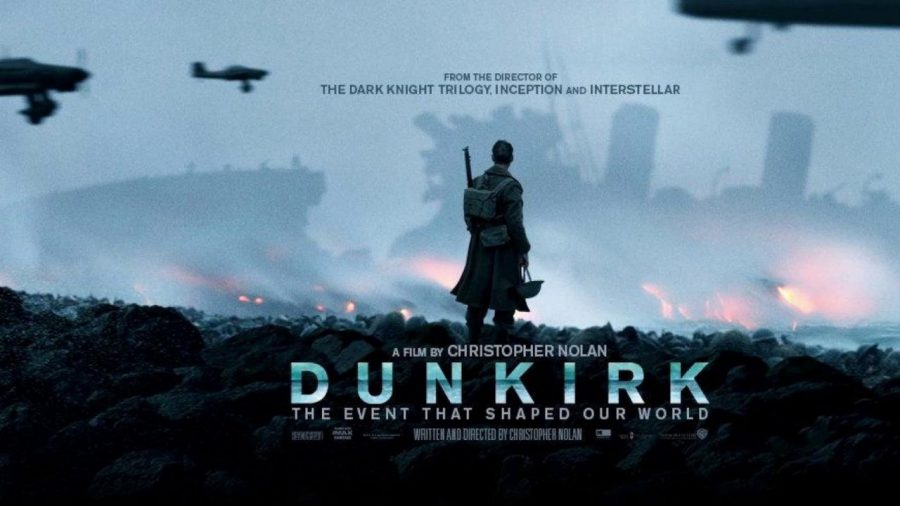Dunkirk Review
November 28, 2017
After Christopher Nolan’s 2014 film, Interstellar, it’s no surprise to me that his next film would be centered on a war. The biggest criticism of Interstellar was that the film was extremely ambitious in its concepts with science. Despite the film receiving praise from most critics, many people saw some key elements of the plot involving science as a stretch. Being that Interstellar was a sci-fi epic, Nolan’s next film was an obvious choice to me; a historical war drama. Dunkirk focuses on British forces trapped in France during the Nazis occupation of France. Going into this film, I was very excited. Any movie directed by Christopher Nolan holds big expectations. But when early reviews began to came out, my interest in the film peaked. Holding an extremely high 94% on metacritic.com immediately caught my attention. The film was being compared to Saving Private Ryan, one of the biggest war movies of all time and one of my personal favorites. Of course, all of this hype only increased my expectations, so I was eager to see the movie.
Dunkirk alternates between three story all with different groups of people throughout the film, each with a different name. The first of these is called The Mole (One Week). This portion of the film depicts a group of soldiers trying to sneak their way out of France. The second is called the Sea. This portion follows three citizens on a boat trying to rescue British soldiers. The final is called The Air. In this portion, two pilots fight through dogfights with enemy planes over the English Channel providing air support for the troops on the coast. The decision to cut between three different stories with different characters and all taking place at different times has its pros and cons. It takes away from some connection to the characters as no one characters stands above the others. However, it does work well to give the film a chaotic feeling, cutting from story to story until the climax when all three stories collide. In The Mole, Fionn Whitehead leads as Tommy, in the group of soldiers desperate to escape the warzone. The group goes from boat to boat, getting kicked off or nearly killed by torpedoes. Along the way, he’s joined by Gibson, played by Aneurin Barnard, and Alex, played by Harry Styles. The casting of Harry Styles gained a lot of buzz after the news broke. In my opinion, he played the role surprisingly well. In The Sea, Mark Rylance plays a sailor named Mr. Dawson who along with his son and a boy named George sail to Dunkirk to rescue soldiers. As they sail through the English Channel, they save a soldier from a sinking ship. This particular soldier, played by Cillian Murphy is never named. However, his character is still one of the more interesting in the film. Obviously shaken from nearly drowning, when he is told that they’re going back to Dunkirk, he panics and pushes George down the stairs of the boat. He suffers from a severe concussion, but they continue on their journey. In The Air, Tom Hardy plays a pilot named Farrier flying with another pilot named Collins. During a dogfight, Collins is shot down, so Farrier returns to the coast while running low on fuel. The film reaches its climax when the three stories all come together. Tommy and the other soldiers board a ship heading back to England. Collins crashes into the sea and is saved by Mr. Dawson. The boat the Tommy is on is bombed and they begin to sink. Oil from the boat fills the water and is lit on fire. Mr. Dawson’s boat comes, and saves as many of the drowning soldiers as he can. As Farrier arrives at the coast, an enemy plane arrives and starts bombing the soldiers on the ground. Farrier shoots down the plane just as he runs out of fuel. The soldiers cheer for him as he lands far away from the base. He then lights his plane on fire with a flare in order to be caught by the Germans.
Dunkirk is a film that is very different from most war movies. Its unconventional storytelling sets apart from classics like Saving Private Ryan and All Quiet on the Western Front. Since the film has no real central character, it relies on the action and brutality of the war for its driving feature. Christopher Nolan has said that the film isn’t about heroism but survival, and this is evident from the start. Throughout the film, characters are faced with extreme choices for their survival, especially in The Mole. The film is extremely effective at conveying a sense of chaos in all three parts and the score helps to set an unnerving feeling in all of the intense moments of the film. Hans Zimmer’s score features a ticking clock at many points, filling every scene with an undeniable anxiousness that keeps you on the edge of your seat. In the end, Dunkirk is carried by its tense action sequences and Nolan’s expert directing. My biggest complaint with the film was its lack of character. Since the film jumped from three separate stories, none of the characters were fleshed out enough to hold much significance. Many character arcs feel incomplete or just fell flat of my expectations. However, I definitely enjoyed this film and I’m excited to see what Nolan has planned next. I give Dunkirk a ⅘.












